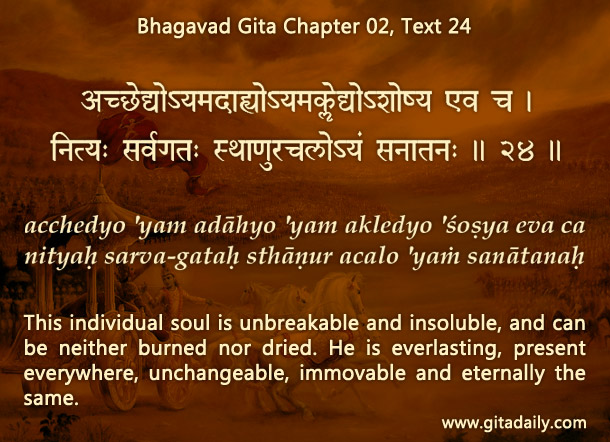“Waterproof!” Declares the ad of a trendy gadget. Ads like these tap our apprehension that such gadgets may get inadvertently damaged. These apprehensions stem from our deeper fear, conscious or subconscious, of the destructibility of all the things around us, even our bodies.
To counter this anxiety, we try to increase the durability and longevity of the things around us. This effort is coterminous with human existence. In the past, warriors sought armors, terrestrial and celestial, that were arrow-proof, the way soldiers today seek bulletproof armors. Yet no matter how well we boost the strength of material things, they still remain vulnerable to time. Nothing material can ever be time-proof.
Yet this doesn’t mean that we need to abandon our natural search for security – we just need to redirect it from matter to spirit, more specifically from the material body to the spiritual soul that is the essence of our identity.
The Bhagavad-gita (02.24) underscores the utter indestructibility of the soul – phrased in contemporary terminology, the verse’s import is that the soul is bulletproof, fireproof, waterproof and windproof. This list is indicative, not exhaustive. That is, without exhaustively listing all the ways in which the soul is immune to destruction, the verse conveys through indicative examples the principle that the soul is indestructible. The universality of that principle is underscored by the verse’s next describer for the soul: eternality. The time that deteriorates and destroys everything material can’t wear down the soul – it is time-proof.
When we seek security in the eternality of our spiritual existence, we can stay unfazed amidst the most destructive of worldly calamities. And when we seek security in the love that brings purpose to existence, specifically the immortal love between us and Krishna, then our love attains perfect and perennial fulfillment – it becomes frustration-proof.

Explanation of article:
https://www.youtube.com/watch?v=vul_KT7Ex6g
Podcast:

Hare Krishna!!
Very to the point description of the verse…redirecting ourselves from ‘matter to spirit’.
Thanks.
I cam eacross one of the posts in face book by a friend in face book which said
God :–
Dear atheists ,Thank you for not killing any children.You are doing great without religion.
Please comment on this.
The killing of children by the Taliban is horrendous, but this comment on it by atheists is sickeningly self-congratulatory.
1. They invoke a God in whose existence they don’t believe.
2. They put words in his mouth that confirm their distorted notions about religion.
3. So, for such atheists, a non-existent God pops into existence just to congratulate them and conveniently pops out of existence.
The absurdity of such self-serving logic would be laughable, but that atheists are stooping to such a nadir of exploiting the murder of children to compliment themselves is sickening.
ys
ccdas
I have addressed the issue more here:
http://www.thespiritualscientist.com/2014/12/does-god-like-atheists-more-than-religionists-because-atheists-dont-kill-children/
ys
ccdas
“And when we seek security in the love that brings purpose to existence, specifically the immortal love between us and Krishna, then our love attains perfect and perennial fulfillment – it becomes frustration-proof.”
Jaya!
Hare Krishna prabhuji,
i was just wondering if another line suits as a continuation to the title of this article
“The soul is bulletproof, fireproof, waterproof, windproof – and time-proof BUT NOT FOOL PROOF”, It came to my mind because soul being a marginal potency has the possibility of getting illusioned by material energy and thus get fooled.
just thought i should share with you.
forgive me if i it is foolish or offensive.
thank you
ys
upendra
Nice – thanks.
ys
ccdas